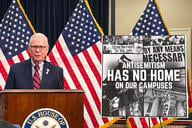You have /5 articles left.
Sign up for a free account or log in.
Sunday night, a University of Cincinnati police officer followed a car off campus before pulling it over for not having front license plates. A few minutes later, a shot rang out and the man inside the car was dead.
The death of Sam Dubose, an unarmed black man, at the hands of a white officer is sparking protests in Cincinnati, and the university president is taking steps to build community connections that he hopes will prevent future incidents.
After the 2001 Cincinnati riots, the largest race-related demonstrations since the Los Angeles riots, the Collaborative Agreement was formed.
Created in 2002 by the Cincinnati police force, the city government, the Cincinnati Black United Front and the American Civil Liberties Union of Ohio, the document lays out ways police officers and officials and members of communities can work together to improve relationships between citizens and law enforcement, educate the public on police procedures and improve hiring, education and accountability within the Cincinnati police department.
The University of Cincinnati has now agreed to join the agreement as one of the steps it will take in response to the death of Dubose.
University President Santa Ono said the campus police force will work with the organizations within the Collaborative Agreement and will help to review the university’s relationships with surrounding communities.
“We want to make sure the university is really applying best practices in terms of how they’re handling the public safety of our community,” Ono said.
He said he will meet with leaders involved in the agreement early next week, and was already meeting with community leaders, such as pastors of local parishes and owners of nearby businesses, to discuss safety in the area.
He said the university's police force will also undergo an institutional review to ensure that best practices are being adopted for officers, including looking at topics like training and cultural competency education, although plans for that review are still in the preliminary stages. A permanent independent committee will be created to conduct the review.
On Thursday, the university announced a change in its patrol policies -- a shift under which the shooting might not have taken place. The change in policy: "UC Police will focus its patrols within campus boundaries. UC has multiple campus locations, so university police vehicles will still be seen traveling between locations. The City of Cincinnati Police Department has agreed to increase its patrols outside the boundaries of campus in the interim. UC Police will conduct traffic stops only within the boundaries of UC’s campuses."
Many black leaders in the city have been upset with the official response to the shooting, requesting that footage from the body camera worn by the officer be released. While the footage is ready to be released by the university, Cincinnati officials said it wouldn’t be made public until a full investigation is complete, at the request of the county’s prosecutor.
Protests are being planned by critics of the university police force.
Ono said that many at the university are “down” in spirits as they deal with the effects of having a tragic event be tied so closely to their own campus.
David Perry, the immediate past president of the International Association of Campus Law Enforcement Administrators and the vice president for safety and chief of police at Florida State University, said that by joining the agreement, the university was solidifying its relationship with the immediate Cincinnati neighborhoods and displaying a commitment to public safety in the area.
“It reinforces the community concept, that the university is connected to the community and that the community is connected to the university,” he said.
Perry noted that the campus police force is going through a period of transition, as a new chief was hired nearly a year ago and is now seeking accreditation for the force, something it currently does not have.
He said that because the campus is in an urban area, it becomes lumped into national discussions about race, policing and other topics. The shooting is gaining national attention as it fits into a countrywide dialogue involving incidents in Ferguson, Mo., Baltimore, and now in Texas, with the death of Sandra Bland.
“I hope they allow the University of Cincinnati police department to review and respond and really see exactly what happened before people rush to judgment,” Perry said.
Officers in the University of Cincinnati police force are allowed to carry weapons. Tasers were banned at the university after a student died after a campus police officer used a Taser on him in 2011.




